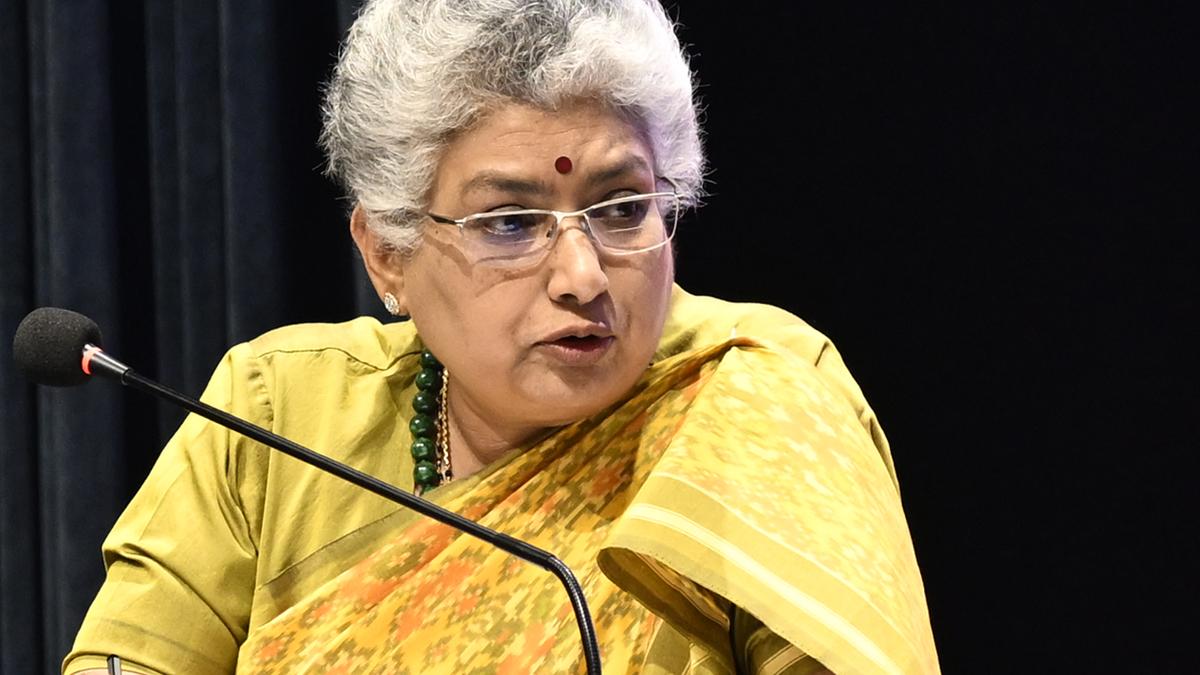News
Nalin Prabhat IPS A Veteran Strategist in Counter-Terrorism

Over the last three decades, Nalin Prabhat, a distinguished IPS officer, has remained on the forefront of India’s security problems. Being in the threshold of his career because of enormous experience in counter-terrorism and anti-Naxal operations, he is very well-known. He has shown absolute commitment to serving the nation until the last breath in the fight against threats to national security. He was appointed as the Special Director General of Police, Jammu and Kashmir, which has remained in the furnace of insurgency and terrorism for decades, at a very juncture when the insurrection and terrorist activities have reached a crescendo pitch on September 30th, 2023. His appointment comes at an extremely critical moment and is a credibility index of the trust the Indian government reposes in his capabilities.
| Category | Details |
| Name | Nalin Prabhat IPS |
| Designation | IG |
| Date of Birth | 14 Aug 1968 |
| Cadre with Year | Andhra Pradesh, 1992 |
| Educational Qualification | – BA Honours |
| – MA (St Stephen’s College) | |
| Medals/Awards/Decorations | Medals: |
| i. Police Medal for Gallantry with 2nd bar (three times) | |
| ii. Parakram Padak (Wound Medal) | |
| iii. Police Medal for Distinguished Service | |
| iv. Police Medal for Meritorious Service | |
| v. Antrik Suraksha Padak (Andhra Pradesh) | |
| vi. Antrik Suraksha Padak (Jammu & Kashmir) | |
| vii. Police (Special Duty) Medal with Bar (Jammu & Kashmir) | |
| Commendations: | |
| i. Hon’ble CM of Andhra Pradesh (2003) | |
| ii. DG ITBP (2005) | |
| iii. DG CRPF (2007, 2008, 2009, 2014 (two), and 2015 (three)) | |
| iv. DGP Jammu & Kashmir (2008, 2010) | |
| Appreciations: | |
| i. Hon’ble CM of Jammu & Kashmir (1) | |
| ii. DGP Andhra Pradesh (3) | |
| iii. DGP Jammu & Kashmir (2) | |
| iv. DG CRPF (5) | |
| v. DGP Punjab (1) | |
| vi. SDG Training (1) | |
| vii. SDG Jammu & Kashmir Zone (2) | |
| viii. ADG CRPF (1) | |
| Posts/Positions Held | SP Karimnagar, Andhra Pradesh: Apr 1998 to May 2001 |
| SP Cuddapah, Andhra Pradesh: May 2001 to Nov 2001 | |
| SP Warangal, Andhra Pradesh: Nov 2001 to Jun 2004 | |
| DDG NDRF: Jul 2004 to Sep 2004 | |
| Commandant 14 ITBP, Srinagar: Oct 2004 to Jun 2005 | |
| Commandant 21 ITBP, Srinagar: Jun 2005 to Nov 2005 | |
| Commandant 16 ITBP, Ladakh: Nov 2005 to Dec 2006 | |
| DIG South Kashmir Ops Range, CRPF: Jan 2007 to Jan 2010 | |
| DIG Chandigarh Range, CRPF: Jan 2010 to Mar 2010 | |
| DIG Bastar Ops Range, CRPF: Mar 2010 to May 2010 | |
| DIG Chandigarh Range, CRPF: May 2010 to Dec 2010 | |
| DIG Ops, Int and Training, J&K Zone and Srinagar Sector, CRPF: Dec 2010 to Jun 2012 | |
| IG ANO Maharashtra, CRPF: Jun 2012 to Apr 2013 | |
| IG Kashmir Ops Sector, CRPF: Apr 2013 onwards |
Early Life and Education
Born and raised in a family steeped in academic pursuits, Nalin Prabhat always had this innate inclination to serve the general public. He did his higher education from premier institutions, thus laying a very strong foundation in law and order. This was further strengthened by training at the National Police Academy, which would go on to help him build skills in negotiating complex issues that have since come to mark his life.
Career Milestones
Counter-Terrorism Expertise
In his illustrious career, one distinguishing factor has been the experience Nalin Prabhat gathered in anti-terror operations. His in-depth knowledge of the working style of terrorist groups and their modus operandi added to his strategic acumen, which helped in neutralizing several threats to national security. His leadership in multiple high-profile operations earned him laurels from both the government and the public.
Anti-Naxal Operations
Besides the campaigns against terrorism, Nalin Prabhat has been in the thick of action when one speaks about countering one of India’s most dreadful Maoist insurgencies—Naxalism. His well-thought-out approach to this has been an aggressive military action in most cases and other initiatives that deal with the socio-economic root cause of the problem. His efforts brought about a decline in violence related to Naxal in his areas of jurisdictions.
Jammu and Kashmir: A New Challenge
The appointment of Nalin Prabhat as Special DGP for Jammu and Kashmir testifies to his vast experience and expertise. Jammu and Kashmir has been one of the volatile regions in the country. Problems of terrorism, cross-border infiltration, and internal unrest have remained there. Hence, Prabhat’s role is immense in implementing such policies that restore peace and stability to the troubled region.
Strategic Vision and Leadership
The leadership style of Nalin Prabhat is a judicious blend of firmness and empathy. He has a reputation as a hard-nosed, yet effective, decision-maker under pressure, which was integral to his advancements in the police force. Equally significant, he knows that in places like Jammu and Kashmir, torn apart by conflict, it is essential to win over the hearts and minds of the local people.
In his strategic vision, he predicts a multi-dimensional approach to security. On one hand, he stands strongly for the strong military effort against insurgents and terrorists. On the other, he contributes very forcefully to the developmental work intended to bring long-lasting peace and prosperity into troubled regions. This dual approach has won him respect, not only among peers, but also within the very communities he serves.
Achievements and Awards
Nalin Prabhat has been awarded many awards and commendations during his illustrious career. Some of these include:
- President’s Police Medal for Distinguished Service: This prestigious award was given to him for his distinguished service to the nation.
- Police Medal for Gallantry: He was awarded this medal for displaying exceptional courage in the face of extraordinary danger on many occasions during different operations.
- Special Mention for Anti-Naxal Operations: Of particular praise has been his role in containing the Naxalite activities, for which he earned special mention by the government.
The Road Ahead: Challenges and Expectations
High expectations ride on his role as Nalin Prabhat takes up his new assignment in Jammu and Kashmir. A meandering militancy has held the region hostage for decades with lasting peace remaining elusive despite many efforts. Prabhat’s task is not only that of neutralizing immediate threats but creating an environment that shall be conducive to long-term stability.
Infiltration of terrorists from across the border is one of the major challenges that he faces. Geographically, Jammu and Kashmir’s proximity to the LoC has made it easy for cross-border terrorism. Prabhat’s strategy is likely to consist of enhanced intelligence gathering, better coordination between the security forces, and emphasis on cutting off logistical support to terrorist networks.
The other critical function of his job will be to listen to the grievances of the local population. There has been much distrust created between people and the security forces due to the years of conflict. It is through community outreach programs and making sure that the law is applied fairly and justly that he will win hearts and minds of the people.
Conclusion
Nalin Prabhat IPS is not only a police officer but a strategist, leader, and torch bearer of hope in areas of violence and turbulence. His appointment as Special DGP, Jammu and Kashmir, itself speaks volumes about the confidence of the government in him to steer that troubled region to peace and stability. With this new innings of his career, he is being watched with bated breath by the whole nation, wishing that this would turn out to be a changing moment in one of India’s most troubled regions.
News
Supreme Court Judicial Critique and the Legacy of Justice Krishna Iyer

The Indian judicial system has long been renowned for its dedication to justice, fairness, and legal principles. Central to this system is the Supreme Court of India, a pillar of integrity where justices weigh the nation’s most pressing legal concerns. Recently, discussions have intensified around the remarks made by Chief Justice of India (CJI) concerning Justice V.R. Krishna Iyer. As one of the most influential judges in India, Krishna Iyer’s legacy continues to shape the judiciary, though not without criticism. Here, we delve into the CJI’s criticism of Krishna Iyer, examining its context, impact, and implications for judicial independence and accountability.
Understanding the Context: Supreme Court Dynamics
The Role of the Supreme Court Bench and Judiciary Dynamics
The Supreme Court functions on the foundational principle of checks and balances. Composed of a nine-judge bench, the Supreme Court’s duty is to interpret the Constitution, uphold civil liberties, and ensure the government’s actions align with legal standards. Given the diversity in judicial philosophy and interpretive approaches among justices, critical exchanges are not uncommon. However, it is rare for a Chief Justice to publicly question the approach of a former judge of such standing as Justice Krishna Iyer.
Judicial Independence: A Cornerstone of Democracy
Judicial independence remains critical to safeguarding democratic principles, preventing undue influences from swaying the course of justice. This freedom allows judges to interpret laws based on the Constitution, immune to external pressures. Any perceived attack on the legacy of a judge as notable as Justice Iyer raises concerns about institutional respect and unity within the judiciary.
Justice Krishna Iyer’s Judicial Legacy and Philosophy
Social Justice Advocate
Justice V.R. Krishna Iyer, a towering figure in Indian law, was known for his progressive judgments and advocacy for marginalized communities. He championed human rights and voiced strong opinions on social justice. His judgments sought to democratize access to justice, and he used his position to protect individual liberties, particularly for underrepresented communities.
Notable Judgments by Justice Krishna Iyer
- Maneka Gandhi v. Union of India – Justice Iyer expanded the scope of personal liberty under Article 21, a landmark interpretation that fundamentally shaped Indian jurisprudence on fundamental rights.
- Bachan Singh v. State of Punjab – In this case, Iyer’s dissent played a crucial role in capital punishment debates, promoting a reformist perspective that continues to influence judicial thinking.
- Govind v. State of Madhya Pradesh – His interpretation in this case broadened the concept of privacy rights, laying the groundwork for future privacy-related judgments.
Justice Iyer’s philosophy centered around constitutional morality, balancing individual rights with societal needs. His dissenting opinions often reflected his commitment to human dignity and egalitarian principles.
The Chief Justice’s Criticism and Its Implications
Evaluating the Criticism
The recent comments by the Chief Justice of India regarding Justice Iyer’s judgments have sparked considerable debate. This critique, which suggests that some of Iyer’s judgments may have exhibited judicial overreach or activism, raises questions about the extent to which judges should interpret the law versus strictly adhering to the letter of the Constitution.
Justice Iyer’s judgments often pushed traditional boundaries, and the CJI’s remarks reflect an ongoing debate over judicial activism. While some view activism as essential to addressing societal inequalities, others argue that it risks politicizing the judiciary.
Impact on Judicial Integrity and Public Perception
Criticizing a former justice in such a manner can influence public confidence in the judiciary. As guardians of justice, Supreme Court judges are expected to maintain collegiality and mutual respect. When a Chief Justice publicly questions a former judge’s approach, it can lead to perceptions of discord within the judiciary, potentially eroding trust in the institution’s objectivity and impartiality.
Moreover, it may impact future interpretations of Justice Iyer’s judgments, leading to re-evaluations or more conservative readings of social justice issues that he ardently championed.
Judicial Activism vs. Judicial Restraint: A Delicate Balance
What is Judicial Activism?
Judicial activism refers to judges shaping policy through their rulings, often filling in legislative gaps or interpreting laws in a manner that addresses pressing social issues. Justice Iyer epitomized this approach, believing that law should serve social welfare and human dignity. However, judicial activism has its critics who argue that it infringes on legislative authority.
Judicial Restraint: An Alternative Approach
Judicial restraint emphasizes minimal judicial interference, urging judges to interpret laws strictly according to the Constitution. Advocates argue that it maintains separation of powers and prevents the judiciary from assuming a legislative role. The CJI’s recent comments may reflect a preference for this conservative approach, valuing constitutional literalism over moral interpretation.
The Debate in Modern Context
As society progresses, so do the legal challenges that emerge. Issues such as privacy rights, digital freedoms, and gender equality require interpretations that evolve with societal norms. The judiciary is often tasked with finding a balance that addresses modern issues without overstepping its role. Justice Iyer’s activism remains relevant, reminding us that the law must adapt to changing times, while the CJI’s critique calls for caution in judicial expansion.
The Importance of Constructive Judicial Discourse
Healthy Debate Within the Judiciary
While such public criticism might seem controversial, it also underscores the value of open debate within the judiciary. Disagreements allow the judiciary to reflect on its own practices and ensure that legal interpretations remain consistent with constitutional values.
Strengthening Judicial Accountability
Criticism among judges can enhance judicial accountability, prompting judges to carefully consider the far-reaching implications of their rulings. By fostering a culture of scrutiny, the judiciary can become more self-aware and committed to its responsibility toward citizens.
Long-Term Implications for Future Judgments
The CJI’s remarks may influence how future judges approach cases, particularly those involving social justice and constitutional interpretations. Future benches may lean towards a more conservative application of law, potentially affecting the legacy of progressive judicial interpretation.
Conclusion: Upholding the Spirit of Justice in a Changing World
Justice Krishna Iyer’s contribution to the judiciary cannot be overstated. His legacy embodies a vision of inclusive justice, where the rights of individuals are safeguarded, and social equity is prioritized. The Chief Justice’s recent critique does not negate this legacy but instead highlights the judiciary’s ongoing dialogue on judicial philosophy and interpretive boundaries. For India’s judiciary to continue serving its constitutional mandate, it must find the right balance between restraint and activism—a dynamic that will ultimately shape the country’s legal landscape.
News
Reliance Jio’s 2025 IPO: A Potential Milestone in Indian Market History

Reliance Jio, one of India’s largest telecommunications giants led by Mukesh Ambani, is gearing up for an IPO (Initial Public Offering) in 2025. With a market-shaking potential, the upcoming Reliance Jio IPO is anticipated to be India’s largest IPO to date. This bold move follows the success of Reliance Jio in transforming India’s telecom and digital service landscape, and the IPO could drive substantial capital investment into the country’s fast-growing tech ecosystem.
What Sets Reliance Jio Apart?
Reliance Jio has revolutionized digital access in India. From its inception, Jio has redefined connectivity for millions, delivering affordable internet access and advanced telecommunication services. Its broad user base and cutting-edge infrastructure make it a strategic player in India’s digital growth. The brand’s 5G rollout and strong digital footprint uniquely position it to attract investors in one of the world’s most dynamic telecom markets.
The Anticipated Scale of Reliance Jio’s IPO
Jio’s IPO aims to raise billions, with reports suggesting it could exceed the size of previous major Indian IPOs. Market analysts predict the IPO may set records, given Reliance Jio’s strong market position, substantial user base, and continual expansion across digital platforms. The raised capital will likely fund further advancements, positioning Jio to expand its services and influence within and beyond the telecom industry.
Potential Impact of the Reliance Jio IPO on the Stock Market
The Jio IPO could boost investor interest in the Indian stock market, drawing both domestic and international investors. Historically, Reliance Industries’ strategic moves have impacted broader market trends, and Jio’s IPO could stimulate significant market activity, benefiting various stakeholders across sectors.
Investor Interest and Strategic Partnerships
Given its extensive user base, advanced technology, and scalable digital platforms, Reliance Jio is expected to attract interest from both institutional and retail investors. Additionally, strategic partnerships with global tech firms may enhance Jio’s appeal to investors seeking exposure to India’s growing digital economy.
How Will the IPO Strengthen Reliance Jio’s Vision?
Reliance Jio’s IPO will likely provide the capital needed to accelerate its mission of digital empowerment in India. With a robust infrastructure and an expanding 5G network, Jio is focused on leveraging its resources to enhance connectivity and digital solutions. The IPO proceeds may further support Jio’s ventures in areas like cloud services, IoT, AI, and digital content.
Preparing for an Historic Market Debut
Reliance Jio’s IPO represents not just a financial event but a significant milestone in India’s digital journey. Investors and market analysts are watching closely as the company prepares for a potential landmark IPO that could reshape both the tech and telecom landscapes.
News
Elcid Investments: A Historic Surge in Share Price

On October 29, 2024, Elcid Investments made headlines by overtaking MRF to become India’s most expensive stock. This remarkable feat was largely driven by a BSE auction aimed at price discovery for holding companies, resulting in each share of Elcid being valued at an astonishing Rs 2.25 lakh. In a dramatic twist, the smallcap stock saw its price skyrocket from a mere Rs 3.53 to an incredible Rs 2,36,250 in a single trading day—a staggering increase of 66,92,535%. Meanwhile, MRF shares closed the day at Rs 1.22 lakh, marking a 0.61% decline.
This article will delve into the factors contributing to this unprecedented rise in Elcid’s stock price, the broader implications for the Indian market, and what this means for investors and market participants.
Understanding Elcid Investments
Elcid Investments is a registered non-banking financial company (NBFC) categorized under investment companies by the Reserve Bank of India (RBI). The firm does not operate any business of its own; rather, it focuses on investments in other companies, boasting a diverse portfolio that includes significant stakes in industry giants like Asian Paints. Its primary revenue source is the dividends generated from these holdings, alongside a notable investment portfolio worth over Rs 11,000 crore.
The Role of the BSE Auction
The surge in Elcid’s share price can be attributed to a special auction conducted by the Bombay Stock Exchange (BSE) on October 28, 2024. This auction was part of a broader initiative spearheaded by the Securities and Exchange Board of India (SEBI) to enhance price discovery mechanisms for investment companies (ICs) and investment holding companies (IHCs).
Historically, many of these firms traded significantly below their book values, creating a disconnect between market perception and underlying asset values. To rectify this, SEBI introduced a framework for “special call auctions with no price bands,” designed to improve liquidity and investor interest in these stocks. The auction resulted in a price discovery that set the opening price for Elcid at Rs 2.25 lakh on October 29, a value still considered below its intrinsic book value.
The Market Reaction
The announcement of Elcid’s new price immediately sparked interest and disbelief among market participants. Social media platforms, particularly X (formerly Twitter), became abuzz with reactions as traders and investors processed the shocking leap in valuation. Many expressed astonishment at the rapid transformation of Elcid from a low-priced stock to one of the most valuable in the market.
This dramatic rise raises critical questions about valuation methodologies and market behavior. Investors often look for indicators of a stock’s worth, including earnings reports, dividend yields, and market sentiment. The BSE auction method, particularly one without price bands, is relatively new and brings both opportunities and risks.
Financial Performance and Growth
Elcid’s financial performance has shown promise, particularly in the June quarter of 2024. The company reported a net profit of Rs 135.95 crore, reflecting a substantial increase of 39.57% from Rs 97.41 crore in the same period the previous year. Additionally, net sales were recorded at Rs 177.53 crore, a 38.28% growth compared to Rs 128.38 crore in June 2023.
Such robust financial metrics, combined with the company’s extensive investment portfolio, play a crucial role in its newfound valuation. As Elcid continues to receive dividends from its various investments, its financial health appears to be on a strong upward trajectory.
Investment Implications
The meteoric rise of Elcid Investments offers several lessons and implications for investors:
- Volatility and Speculation: The sheer scale of Elcid’s price movement underscores the volatility that can occur in the stock market, especially with smallcap stocks. While such dramatic increases can yield significant short-term profits, they also carry substantial risks. Investors must conduct thorough due diligence before entering the market, especially in cases of extreme price volatility.
- Value Investing vs. Speculative Trading: The disparity between Elcid’s auction price and its book value invites discussions about value investing versus speculative trading. While some investors may seek to capitalize on rapid price changes, others may prefer to invest based on long-term fundamentals and intrinsic value.
- Regulatory Influence: SEBI’s intervention in price discovery showcases the importance of regulatory frameworks in maintaining fair market practices. The auction method could be a model for future initiatives aimed at improving liquidity and investor confidence in various sectors.
- Portfolio Diversification: Elcid’s focus on investments in established companies like Asian Paints serves as a reminder of the benefits of diversification. Investors are encouraged to spread their investments across different sectors to mitigate risks associated with individual stocks.
The Future of Elcid Investments
With its recent price surge, Elcid Investments has positioned itself as a significant player in the Indian stock market. However, sustaining such a high valuation will depend on several factors, including continued performance of its investments, market conditions, and regulatory developments.
As of now, the company’s valuation is still below its book value, indicating potential for further upside if it continues to grow its investment portfolio effectively. The company’s approach to managing its holdings and generating returns through dividends will be closely monitored by investors.
Broader Market Implications
Elcid’s rapid ascent is not just a story of one company’s success; it reflects broader trends in the Indian market. The dramatic shifts in stock prices serve as a reminder of the potential for sudden changes in investor sentiment, which can lead to equally rapid declines as seen in many speculative bubbles.
Furthermore, Elcid’s rise may encourage other smallcap and midcap companies to reevaluate their pricing strategies and consider engaging in similar price discovery auctions. This could lead to a more dynamic market landscape, where the focus shifts toward more transparent and fair pricing mechanisms.
Conclusion
Elcid Investments’ phenomenal journey from obscurity to becoming India’s most expensive stock exemplifies the unpredictable nature of the stock market. It highlights the importance of regulatory frameworks in shaping market dynamics and investor behavior. While the company’s recent financial performance has been encouraging, the future remains uncertain as it navigates the complexities of the market.
Investors and market participants must remain vigilant, recognizing the inherent risks and opportunities presented by such volatile stocks. As Elcid continues to make waves on Dalal Street, its story serves as both an inspiration and a cautionary tale for those looking to make their mark in the world of finance.

 Celebrity2 months ago
Celebrity2 months agoKim D’Estainville: A Brief Biography of a Distinguished Media Executive

 Celebrity2 months ago
Celebrity2 months agoWho is Josh Gates’ Daughter? A Look Into the Family Life of the Famous Explorer

 Celebrity3 months ago
Celebrity3 months agoSamay Raina Biography

 Celebrity4 months ago
Celebrity4 months agoLove Kataria Biography

 Celebrity2 months ago
Celebrity2 months agoMikki Mase Net Worth 2024: The Rise of a Gambling Maverick

 Sports3 months ago
Sports3 months agoSimone Biles Biography

 Celebrity3 months ago
Celebrity3 months agoLeAnn Rimes to Shake Things Up at “The Voice Australia” 2024

 Celebrity2 months ago
Celebrity2 months agoDDG Net Worth: The Rise of a YouTube Star-Turned Rapper
















